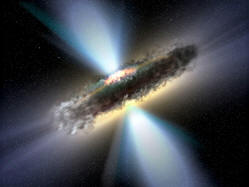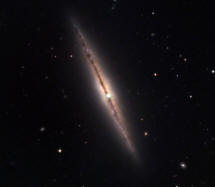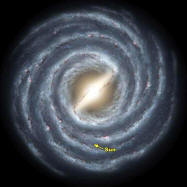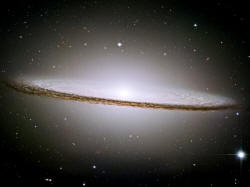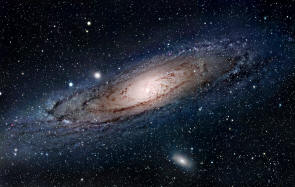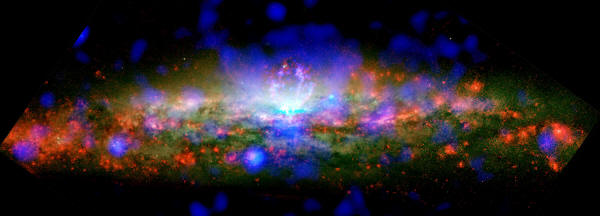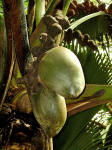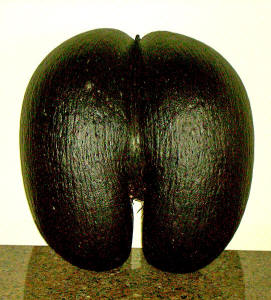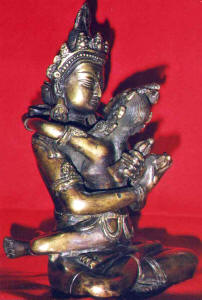Sophia's Fall Explained by John Lamb Lash
I've copied it over here for safe keeping. Make sure to browse for more from JLL and the Bibliotecapleyades archives.
by John Lash
October 2004
from MetaHistory Website
Part One
The Human Role in Gaia's Dreaming
The icon for the Gaia Mythos is a coco de mer with cosmic detailing: sun and moon motifs with the emergent earth indicated by a cross. There is a story that goes with this image, a story crucial to our understanding of what it means to inhabit this planet, Earth.
The Gaia Mythos, an evolutionary myth of Earth, encodes some closely guarded secrets of the Pagan Mysteries. Yet this story is no elite affair, and the "secrets" it contains are open to anyone with the will and capacity to comprehend it.
To love to know, and to love what you know, is the Gnostic way. 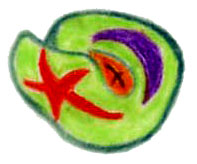
Gnostic Cosmology
The story of the Fallen Goddess is only found in Gnostic materials, and even there it only survives in fragmentary form.
(Technically, this story is a cosmogony - a description of how a world system or cosmos originates - but it is more easily treated as a cosmology, the description of how a world system operates, based on how it originated.)
Fortunately, the slim evidence for Gnostic cosmology is supported by an array of classical lore, cross-cultural mythology, and indigenous wisdom.
In Greco-Roman mythology, for instance, the theme of "the marriage of Ouranos and Gaia" asserts a special link between the celestial realm and Gaia, the living earth. Ouranos, the Greek word for "heaven," refers to the Pleroma, the realm of the gods, or, in astronomical terms, the galactic core.
The mythic "marriage" of the Pleroma and Earth is consistent with the Gnostic scenario of the Aeon Sophia who plunges from the galactic core to be metamorphosed into the planet we inhabit. Sophia is exiled from the Pleroma and "grounded" in the terrestrial domain, but precisely because of the unique conditions under which earth was formed, our planet remains intimately linked to the cosmic center, the galactic core itself.
I have argued elsewhere in this site that a great deal of mythology can be read as astronomy. (This can be done without going as far as Santillana and von Dechend who propose in Hamlet's Mill that myth is nothing but encoded astronomy.) The transposition of myth into astronomy is, of course, a creative act that requires the use of imagination - hence, an exercise of mythopoesis, intentional myth-making.
The Gnostic creation myth provides a unique set-up for such an exercise because it presents just enough enticing clues to whet the imagination and make us try to picture what happened to the Pleromic Goddess, Sophia. What we know today about the large-scale structure of the galaxy, the birth of the sun, the formation of the planets, and the current position of the solar system in the galactic limbs, presents a unique opportunity to re-evolve Gnostic cosmology into a visionary model of our own making.
Doing so, we come to participate empathically in the experience of the Earth Goddess, Gaia-Sophia.
As suggested in Sharing the Gaia Mythos, the purpose of humanity in Gaia's life-process may reside in on our capacity to remember Her Story. Metahistory involves not only a critique of history and the beliefs encoded in it, but also a creative recalling of the mythic dimension of our own species story.
In this respect it should be clear that the reason for converting the mythico-mystical language of Gnosticism into the concepts of modern astronomy is not to use science to legitimate Gnostic vision, but to link our current picture of the cosmos to an ancient seminal visionary experience whose slight traces can be discovered in Gnostic writings.
Even with clear correlations, however, it is extremely difficult to construct a coherent version of the Fallen Goddess scenario. Considered strictly on the basis of surviving texts, there is no "Gnostic cosmology," or almost none. The textual material is in some instances - in most instances, it must be said - corrupt and unreliable.
The Nag Hammadi "library" is a pitiful heap of remnants, like a handful of glass shards from a shattered stained-glass dome.
These documents were translated into Coptic from "Greek originals," scholars say, but there is no way to know if the Greek texts themselves were actually first-hand Gnostic writings. After countless readings, I am inclined to see these texts as study notes, and in rough and incomplete form. The Coptic reads like a slapdash translation made by scribes who did not altogether understand what they were translating.
Fifty fragmentary documents whose content is largely incoherent and maddeningly inconsistent - this is all that remains of what once was countless thousands of parchments and codices, including many works on geology, astronomy, and mathematics, known to have been written by initiates of the Mystery Schools.
To fill in what is missing or badly preserved in the Coptic treatises from Nag Hammadi, we must turn to paraphrases found in the polemics of the so-called Church Fathers who opposed the Gnostics. For the scenario of Sophia's fall and subsequent embodiment as Gaia, for instance, we have to rely on Irenaeus, a Christian bishop who wrote Against Heresies around 180 CE.
A full-scale narrative describing how Sophia becomes Gaia cannot be developed without making huge inferences.
The Fallen Goddess scenario relies at key points on extrapolating broadly - and, one might say, boldly - from the slim evidence on hand.
Lucky Thirteen The thirteenth packet of the Nag Hammadi library consists of eight papyrus leaves, a mere sixteen pages.
It is the only codex (book of bound leaves) found without a leather cover, and uniquely, but for one other codex (II), its pages are not numbered. The texts are incomplete, and the first two leaves appear to have almost been burnt. They are not charred around the edges, but smoke-damaged.
The Arab family whose sons found the codices in a cliffside cave in December, 1945 are known to have burned some leaves to heat water for tea. During the 4th century CE when the cache was buried, fanatic ideologues called the "Church Fathers" demanded that all Pagan and Gnostic writings be burned. The first pages of codex XIII seem to have quite literally been snatched from the flames.
Gnosis is the knowledge that frees. Because this knowledge is precarious, so is freedom. The sole complete text in codex XIII is Trimorphic Protennoia, a title rather grandiosely rendered as "The Threefold Divine First Thought." The scribal hand that copied it resembles that of codex II, but is a more rapid, cursive version, as if it were written in a rush. The experts suggest that it may have been written by two hands, that of student and instructor. (CGL5V, V, B2, p. 362. For my system of references see Gnostic Materials.)
This opinion accords with my own (non-expert) view that the Coptic treatises are student notes, or notes dictated by masters to novices. The materials found under the cliff of Jabal al Tarif may indeed be "Cliff Notes" (the trade name in England for study guides to classic works, such as those of Homer and Shakespeare).
The structure of Trimorphic Protennoia is distinctive. It builds like a fugue in two voices, first-person and third-person. The longer, dominant passages are called "first-person aretologies."
These declarations use "I" for a supernatural agency that declares its traits and actions:
The character of the aretologies is lofty and poetical. The content is visionary, so this kind of text is called a "revelation discourse."
Alternating with the aretologies are passages in the third-person, apparently intended to indicate the student's comprehension of the discourse, or perhaps they are the master's notes interpolated to help the student comprehend. The subject of Trim. Prot. is the central theme of Gnostic cosmology: the descent of the Aeon Sophia into the chaotic realm beyond the bounding membrane of the Pleroma.
Her plunge is described in three distinct stages or increments:
Protennoia means "primary mind intention," or First Thought, as the scholars have it. This word is packed with uniquely Gnostic nuances. "Proto" means both "first, primal or primary" and "generative."
Protoplasm is the biological basis of all life-forms.
A prototype generates all later and subsequent types. Ennoia is a compound of en-, "intent, will," and noia, a variant of nous, "intelligence, mind, consciousness."
The Greek word nous defines in all Gnostic teachings the special endowment that Sophia and the Pleromic gods confer upon humanity. Our wisdom endowment is nous, a dose of divine intelligence, the power to know what gods know. Nous is a faculty, not a mark of identity. Granted, whoever cultivates nous becomes in a sense "god-like," but in no sense is nous a "divine self," the possession of which allows us to consider ourselves to be gods.
The object of Gnostic spiritual practice is not to see ourselves as gods but to see as gods see. A World-Changing Message Scholars working in teams over decades apply meticulous care to eke out the meaning of obscure texts such as Trimorphic Protennoia.
They endlessly scrutinize the variations of grammar, spelling, handwriting. They write papers and sometimes entire books on a single treatise. They hold symposia to discuss the historical and philosophical background of the Gnostic materials, usually with the aim to learn more about the origins of Christianity, rather than to understand what the Gnostics had to say in their own terms.
The result of all this work on the literal meaning of Gnostic texts is that the message they contain is overlooked, if not entirely lost. No scholar today regards the original message of Gnosticism as valid subject matter. This is the strange impasse into which Gnostic studies have led over the last fifty years. About one third of the writing in Metahistory.org is devoted to recovery of the original message. To recover and reconstruct the story of Gaia-Sophia, we must consider what the Gnostics may actually have known about cosmic matters. The assumption that Pleroma, meaning "fullness, plenum," refers to the core of any galaxy, is the first step in allowing that Gnostics had real-world astronomical knowledge.
In short, we infer that Pleroma means galactic core (but not only that), so that we can develop certain imaginative clues in the Coptic material.
(It could be argued that Pleroma is purely a metaphysical locus outside time and space which ought not to be "reified," made into a concrete thing. For my response to this objection, see 'reality' in below insert.)
Scholars do not make such inferences because the limits of their discipline do not allow them to suppose that genuine astronomical knowledge could be encoded in mystical writings.
Obliged to stick to the textual evidence, they ignore the question of what kind of evidence might be provided by direct mystical experimentation, the practice of Gnosis, transcendent insight.
Yet if scholars today do not have experience comparable to that of the Gnostic seers, how can they discover what these obscure texts might be indicating? Lacking the evidence of experience, the experts are constantly forced into omissions. For fear of making false inferences, they make none that cannot be textually supported.
No scholar would do what I am here attempting with the Gnostics materials. But for that matter, no scholar could do what I am attempting. If there is a profound world-changing message in Gnosticism, as I believe there is, it has little chance of reaching the world at large through the filters of scholarly exegesis. Discerning the message Gnostics were trying to give is my overriding concern.
Thus I extrapolate, as best I can. I extrapolate carefully but vastly, because the scope of Gnostic visionary wisdom was vast, as far as I can tell. My inferences are based on a lifetime of experimental mysticism, as well as thirty years' study of the materials and an equivalent period of involvement with mythic cosmologies, modern astronomy, astrophysics, and naked-eye sky-watching.
I am not alone in attributing profound astronomical knowledge to the Gnostics. Jacques Lacarriere, a comparative mythologist and cultural historian, has written the single most accessible book on Gnosticism, demonstrating a complete departure from the usual dismissive treatment. Granted, the book The Gnostics is a poetic meditation, rather than a scholarly exegesis such as one finds in Pagels and King.
Yet Lacarriere presents brilliant insights that enable us to appreciate the spirit of Gnosticism as such, on its own terms, rather than as a footnote to Christianity. He asserts that knowledge of the cosmos among the Gnostics was not a product of fantasy, or "metaphysical" speculation, but derived from observation of the sky, that is, from encountering the real, sensorial universe.
For the Gnostics, the sky is “the first source of knowledge”; astronomical perspective was “implicit at the very starting-point of their thought.” (p. 16) I couldn't agree more.
Lacarriere also extrapolates Gnostic material in ways conventional scholars would find unacceptable. He proposes that Gnostic seers could look into many worlds, and so were able to detect certain cosmic factors specific to the world-system we inhabit. As we shall see, Gnostics taught that our world is aberrant, anomalous.
How could they have known this if they did not have something non-anomalous to compare it to?
Some Gnostic texts assert that there are many Pleromas. We know today that there are billions of galaxies.
The story of the Sophia Aeon concerns one Pleroma in particular, the core of the galaxy that harbors the solar system in its spiral arms. The mere suggestion that mystics who lived 2000 years ago could have had concrete knowledge of events specific to our galaxy is, of course, outrageous.
How all the more outrageous it will be, then, if what they knew turns out to be true. Sophia's Passion As noted above, Trimorphic Protennoia is concerned with the central event of the Gnostic world-vision: the descent of the Goddess Sophia.
The role of the human species in the life of Gaia is set up by the triple descent of Sophia from the Pleroma, especially in the third phase.
To show how this occurs, we need to convert the mystical and theological shorthand of Trim. Prot., summarized in Turner's paraphrase (above), into cosmological terms. The general outlines of the Gnostic origin myth will then become clear.
Then, by inference, we can begin to explore the role of humanity in Gaia's Dreaming of the world we inhabit:
One of the difficulties in recovering the Gnostic origin myth is that textual accounts of this critical phase of the story are lost.
Descriptions of the conversion of Sophia's passions into the material earth, which certainly existed in written versions, have been almost entirely eradicated. The most complete version of this event is not found in the Coptic sources but in the polemical writings of the Church Fathers.
To protest what they regarded as the ornate complication of Gnostic cosmology, the Fathers had to paraphrase the material they so detested. The most complete description of Sophia's devolution into a planetary body is found in Against Heresies by Irenaeus.
Chapter IV of Book One of this immense tome is entitled "Account Given by the Heretics of the Formation of Achamoth, Origin of the Visible World from Her Disturbances." Achamoth, a corruption of the Hebrew Hochma, "cosmic wisdom," is a Jewish term applied by Gnostics to the Fallen Sophia.
Ireneaus writes:
Compare this account to the legend of the Thompson Indians, cited in the Commentary on the Prelude of the Gaia Mythos:
Time and time again, Gnostic visionary teaching is corroborated by indigenous lore.
This makes sense if we regard Gnosticism as an advanced or highly formalized brand of shamanism, a visionary method of high sophistication that arises from the same ecstatic encounter with Sacred Nature as shamanic practices in native cultures around the world.
The Call to Co-Evolution Such is the expanded paraphrase of Trim. Prot. (Trimorphic Protennoia), transposed into astronomical terms.
Where do we go from here?
The third phase of Sophia's descent is still in progress, for the cosmic Aeon, departed from its normal sphere of activity, now persists as the living earth. Here we must extrapolate again in order to form some notion of humanity's role in Sophia's experience.
In the third stage, Sophia's long process of incarnation shifts toward a co-evolving phase. With the emergence of the human species on earth, the Protennoia "assumes a human appearance." This does not mean that God, or more precisely, the Goddess, appears on Earth in human form, but that the appearance of humans on Earth is a particular expression of the Goddess intelligence.
Let's recall that Her name, Sophia, means "wisdom." In humanity, a particular form of cosmic wisdom is germinating. In some way we have yet to grasp, Sophia evolves life on earth, not for human purposes, but to invite human participation in Her story. We participate through cultivating the wisdom endowment She has implanted in us.
In other words, we are endowed by Gaia-Sophia with the capacity for co-evolution. However, what we lack is a clear conception of what co-evolution is and how we might pursue it. We lack a motive. In all other species on earth, cosmic wisdom is also present, of course. In many ways it is more perfectly and harmoniously displayed by non-human creatures. In fact, indigenous wisdom states that we humans are kin to all species and depend for our survival on non-human allies, such as "power animals" who can show us how to apply Sophianic intelligence because they are, in many ways, better at it than we are.
Native American teachings state that,
All too often we feel tragically alone with what we know. We falsely believe human intelligence is superior to all other forms, a freak phenomenon. In the Gnostic perspective, the status of the human species is not one of superiority but of uniqueness, because we have a special responsibility in responding to Gaia's call to co-evolution.
(More on this delicate point in the forthcoming essay, How We Are Deviated, the third part of the trilogy that begins with Coco de Mer, parts One and Two, and includes the essay here underway.)
NHC XIII informs us with enormous brevity how Sophia, upon becoming the Earth, offers a special opportunity to humanity.
She "introduces the illuminatory baptismal light of the Five Seals." This means that from the original Pleromic light which She was and still is, Sophia makes available a kind of extract, consisting of five potentials or faculties.
The language here is deeply mystical, using a kind of insider jargon from the Mystery Schools. The "seals" refer to five powers inherent to nous, the divine intelligence.
These powers are:
This last is acquired through training of paranormal faculties such as clairvoyance and clairaudience.
The initiation program of the Mysteries was set up to produce and test these powers in the neophytes. The Mystery Schools were universities for the practice of noetic sciences, the cultivation of co-evolutionary mind.
If humans claim and cultivate their Sophianic endowment, the Goddess will be able to "restore her members into the light." In other words, what Sophia does through humanity is somehow crucial to re-evolving Her connection of her own capacities ("members") to the Pleroma. This is what Gnostics taught about human involvement in Her "redemptive" process. The Mystery School term for this process is "correction."
The Apocryphon of John says:
Elsewhere this process is called Sophia's "rectification." As Sophia realigns Herself with the Pleroma, humanity is, somehow, deeply implicated in the process. (For more on this tremendous prospect, see correction in below insert.)
In a nutshell, this is the supreme teaching of the Sophianic vision, the redemptive cosmology of Gnosis. Open Revelation Given all this background, what are we to make of the obscure proclamations in NHC (Nag Hammadi Codex) XIII?
Truth be told, there is almost no cosmological content in Trim. Prot.! The text consists of rough notes on a "revelation discourse" in which a Gnostic visionary recalls or recapitulates the descent of the Goddess, but not in a concrete way.
Phases of Sophia's engagement in the extra-Pleromic realm are described, but not graphic cosmological stages as such. The discourse has to be transposed imaginatively to produce a vivid cosmological picture story.
Such revelations have been called "visionary recitals" by Henry Corbin, a scholar of Sufi mysticism whose most well-known work is Creative Imagination in the Sufism of Ibn Arabi. Corbin coined the term "imaginal" to emphasize that what the genuine mystic sees is not imagined (i.e., falsely invented), nor is it merely imaginary (a product of psychic activity, detached from the real world). Rather, he or she see a visionary as opposed to a sensorial "reality." Several texts in the NHC are visionary recitals that provide vital clues to the Gaia Mythos. These texts probably represent transcriptions of notes taken by students on lectures given by initiates who reported their experiences in altered states. The notes would have enabled classes of upcoming students (neophytes) to "review" what their teachers saw in visionary states, as a preparation for exploring those states in their turn.
Literally, "review" means to re-view or re-see. If successful, the training of the neophytes led them to re-see what had already been witnessed and transmitted by their teachers. Each re-seeing was consistent with initiatic experience and, at the same time, enriched with new content, for the manifestation of the Divine to the human mind is an open and ongoing revelation.
Hence the co-evolutionary project of Gnosis.
Opponents of the Gnostics accused them of writing too many books and inventing all manner of complications to explain the cosmos and the human condition. They rejected the possibility of rich, ever-evolving revelation. For the Church Fathers the revelation of the Father God through Jesus Christ was a one-time-only event, and the story was simple and stable. (Upon close analysis, it is anything but, but that is another issue.)
Because Gnostic method left revelation open, its practitioners were involved in a continual process of rediscovery and re-imagination, encompassing the entire course of evolution. They accessed "cosmic memory" to review over and over again the descent of the Wisdom Goddess and refine their understanding of how humanity emerged in Her Dreaming, and how we are implicated in Her "correction."
To be Gnostical today means to continue this process of re-imagination. The Original Moment The cosmic detailing of the Coco De Mer, the icon for the Gaia Mythos, pictures the original Dreaming of Sophia.
In Episodes 5, 6 and 8 of the Gaia Mythos, we see the conditions that prevailed before Sophia plunged beyond the Pleroma, taking Her Dreaming with Her into the lower world.
To summarize briefly those Episodes:
Now we must try to imagine what Sophia dreams as She contemplates the template of Atu Kadmon, the Anthropos, before Her plunge.
While She is still within the proper limits of the Pleroma, She produces the Dreaming of a world to come. Yet She does so in an anomalous manner, by Herself, without pairing off and sharing Her vision with another Aeon.
This is, not a violation, but a departure from the usual operations of "cosmic law."
The will of the Originator does not constrain the Generators, the Aeons who always remain free to act without a counterpart.
Let's imagine that in the original moment of Her Dreaming, Sophia previews a world order that might arise for Atu Kadmon, the human species, but this is not in fact the world order that does arise from Her descent. The material of Trim. Prot. and other texts, as well as the polemic paraphrases, all agree on one crucial point: when Sophia plunges from Pleroma, the effects that She produces in elementary matter are weird and unexpected.
She has an initial vision of a world order, yes, and presumably She retains it on Her descent, but the world system in which She becomes enmeshed does not entirely and consistently reflect Her original moment of Dreaming. Sophia's trimorphic protennoia, the threefold primal intent of her Dreaming, was skewed by unforeseen conditions outside the Pleromic Core.
The Coco De Mer represents - pictures graphically - the triple world system Sophia originally intended to emanate. In Her solitary dreaming Sophia imagined a threefold world order far out in the galactic limbs - a planetary system consisting of one star, a planet and a moon, but this was not the system that arose due to Her fall.
The Gospel of Philip contains a famous one-liner that describes this bizarre development:
High Strangeness This much-quoted line has been used against the Gnostics who are accused of hating and rejecting the material world (nature, the earth) because they regard it as an inferior, flawed creation.
Nothing could be further from the truth. I submit that it is just this, the mistaken character of our world, its deviance from the original Dreaming of Sophia, that engaged the Gnostics in empathy with the earth and the Goddess embodied in it. Seeing cosmic events in affectively charged vision, they realized that Sophia's fall subjected Her to gravitational forces that do not apply to the mass-free hyper-porosity of Aeonic currents in the Pleroma.
Lacarriere writes:
The line from Gos. Phil. could be called a proposition of "high strangeness."
This term is often applied to ET/UFO lore, and it may prove relevant to Gnostic teachings as well. In the "Afterword" to the 1996 edition of the Nag Hammadi Library in English, Gnostic scholar Richard Smith compares the visions of Gnostic cosmology to science fiction, and relates the Sophia Mythos to numerous books and films in that genre.
Among others he cites Philip K. Dick, whose Valis Trilogy is a retelling of the Fallen Goddess scenario. Dick himself attributed his involvement with the Sophia Mythos to a mystical experience he underwent in March 1974, at the age of 46, when a ray of light released a massive download of information into his mind. This experience is consistent with Gnostic illumination resulting in the "visionary recital." Dick's wrote down his in a 200,000 text (as yet unpublished) which he called "The Exegesis."
Throughout the Valis trilogy Dick explores the question of how the wisdom of Sophia can assert itself in the fallen world She has produced, thus liberating humans from their distorted perception of reality.
Dick was convinced that gnosis is special knowledge of our delusional state, revealing how we are deviated. In Valis he attempts to show that only Gnosis can save us from being victims, if not accessories, to the evil and insane patterns of behavior that arise in and around us, not because we are sinful by nature, but because we are ignorant of our true nature.
Gnostic cosmology includes some outrageously strange propositions that work beautifully as science fiction plots.
"High strangeness" may be just what we need to get to the ultimate truth about the human condition on this troubled planet.
A Two-Source Hologram Let's suppose that Sophia's original Dreaming of a world outside the Pleroma persisted, even through the world-system She came to be enmeshed in was not the one She initially imagined. In effect, She ended up living in two systems at once.
And humanity, the embodiment of Atu Kadmon, is right in there with Her.
Philip K. Dick described the bizarre two-world scenario of the Gnostics in the brilliant metaphor of "a two-source hologram." (Valis, p. 178) Holograms (or holographs) are quasi-objects produced by an arrangement of laser beams and mirrors that project into three dimensions a flat image registered on a plate.
Imagine the hologram of a house, projected from an image on one plate, superimposed on another hologram of a similar but structurally different house, projected from another plate.
Both holograms merge to produce a setting whose inhabitants may feel disoriented without knowing why. They may sense, for instance, that they both belong and don't belong in the setting. In some ways they feel quite at home, but in other ways they do things to their habitat that are inconsistent with their survival in it. For the moment the analogy needs no further elaboration.
Before Her plunge Sophia imagined a world outside the Pleroma, the "Triple-Formed Original Thought." This is the world order She intended before She fell into chaos.
It is a system composed of three components:
This is the most simple example of a world system that can arise within the known laws of cosmic physics.
The planet requires a satellite as an "out-rider" or armature so that it can develop conditions for life that will not be overwhelmed by the immense force of the solar body, the mother star.
The world-order thus produced is gourd-like, with the sun and moon forming the "husk" of the system, and the planet (Earth) the juicy pulp - as the Coco De Mer icon shows.
(The gourd analogy is a cosmological trope that plays an explanatory role in other contexts as well. In Sacred Land, Sacred Sex, Rapture of the Deep, Dolores LaChapelle has described how the gourd may be viewed as the first instrument of humanity's civilizing activities.)
The world order previewed by Sophia in the original moment when She gazed from the galactic core out to the spiraling limbs does not come to be, but Her vision persists.
Despite the deviant world system brought about by Her fall, Sophia's original undeviated vision persists and allows for correction of the world system we inhabit. The correction is achieved, in part, through human co-evolution with Gaia's purposes.
This is the essence of Gnostic teaching on redemptive cosmology.
The Coco De Mer is a picture that both triggers and anchors the memory of this teaching. Knowing this to be so, and experiencing it empathically and imaginally, engages us in Sophia's correction. Our responsibility to the earth depends on our involvement in a supra-earthly vision - our total, experiential, even visceral involvement.
As Dick's protagonist says, regarding the bizarre notion of the two-source hologram:
Gnostics taught that the cosmos we inhabit came about by an error, an anomaly, and we are involved in how it is being corrected.
The Coco De Mer icon re-center us in Sophia's Dreaming so that we can grow into an understanding of our role in Gaia's cosmic realignment, Her way home to Her source.
The Three-Body World By visualizing the three-body world, we orient ourselves imaginally to Gaia's Dreaming.
This image reminds us to distinguish Earth from the rest of the planetary system. Gnostic texts always refer to the cosmos (kosmos in Greek) as distinct from the earth itself (ge in Greek) . (In both cases the Coptic words, which I cannot reproduce here because they do not convert in html, are direct transcriptions of the Greek words.)
The kosmos produced by Sophia's initial impact in the realm of elementary matter is not the home planet we inhabit, not the planet Earth, for the Earth was formed differently from the rest of the planetary system. This concept is fundamental to Gnostic cosmology. It is of course complete nonsense in scientific terms. It is "high strangeness" all dressed up in a mystic veil of fantasy. Let's consider this weird notion for a moment, just to see where it takes us.
The "mistake" cited in the Gospel of Philip was not the act of solitary Dreaming by the Aeon Sophia, but the unforeseen impact of Her plunge from the Pleroma. Her tumultuous descent into the galactic limbs produced conditions that resulted in the emergence of a planetary system distinct from Earth.
This is the kosmos we inhabit, the realm of the Archons who arose first, before Earth did. In the language of materialistic science, the cosmos outside Earth is the realm of inorganic chemistry. One of the great mysteries of science is how the organic, the living, arises from the inorganic, the non-living.
(Theodore Roszak quotes an anonymous version of modern cosmology:
The question of how life arose from the lifeless can be answered quite directly in Gnostic terms, but it also needs to be reframed, because it is not quite the right question. Inorganic matter is also alive, albeit in its own way.
The real question is, How do the living structures of inorganic chemistry relate to the structures of organic life?
This is tantamount to asking, How do the Archons, who are inorganic beings, relate to humans, who are organic beings?
Much of Gnostic writing was concerned with this question of the two orders of life, organic and inorganic, terrestrial and Archontic, yet the issue of the Archons is entirely disregarded by scholars. It is not even dismissed as superstitious nonsense, but is merely passed over in silence, deemed unworthy of comment. By distinguishing rigorously between the earth and the extra-terrestrial planetary system, Gnostics were proposing a conceptual model of organic and inorganic worlds. The planetary system as such, the cosmos, does not provide a realm where humanity can live, only the home planet does. All this is true to the facts of astronomy and biology as we understand them today.
So far the outrageous theory stated in the one-liner from the Gospel of Philip carries reasonable information. It makes perfect sense in terms of what we know about the physics of the solar system. The catch is, modern astronomy does not allow that Earth's genesis was different from that of the other planets.
The Gaia Hypothesis, now more commonly known as Gaia Theory, first emerged in 1976 with James Lovelock's reflections on the contrast between the lifeless atmosphere of mars and the life-filled atmosphere of Earth. It is clear, then, that Gaia Theory is a reliable homologue to the Sophianic mythos that distinguishes between the lifeless solar system and the life-bearing Earth.
Gnostic cosmology is visionary and mythic, not scientific in the modern sense of the term, but a great deal of Gaia-compatible science can be extracted from it, as we shall see.
The Coco de Mer (Lodoicea maldivica) is a tall palm tree native to the Seychelles in the Indian Ocean.
Although the mature nut, the largest in the plant kingdom, immediately suggests female anatomy, the morphology of the Coco de Mer is bi-sexual.
Coco de Mer with fruit Male Coco de Mer inflorescence
Shapes suggestive of both male and female structures occur on separate Coco de Mer palms, but the strange bi-lobed nuts were discovered long before the palm itself, leading to mythical attribution of magical or self-propagating powers, typical of the Sacred Feminine.
Coco De Mer - Mature fruit
Virgin Stereotype Type "coco de mer" in Google and the first entry you will see is a pornographic site with video streaming guaranteed to satisfy your most extreme desires.
A little further down the line there is Coco de Mer, "an up-market ladies erotic fashion and toy shop" in Covent Garden, a finalist in the 2002 Erotic Awards in the category for "Erotic Disability-Friendliness."
Erotic disability?
Now there's a concept that invites some ripe reflection. (More on this issue below.)
In southern India, where Coco de Mer nuts often wash ashore, the sleek, wet, glistening object is enshrined in the inner sanctum of temples and "worshipped as in image of the vulva of the Goddess." (Philip Rawson, Tantra: Indian Cult of Ecstasy, p. 23) What kind of perception is required for such a natural object to be taken for a religious icon?
The erotic-religious crossover occurs frequently in Asian traditions: consider the yab-yum, the icon of mating gods, in Tibetan Buddhism, or the lingam and yoni in Indian Tantra.
Yet it would be totally wrong to regard this act of visualization as due to overheated sexual drive, or some kind of "primitive" fascination with human genitalia. In fact, this crossover occurs predominantly in the most intellectually sophisticated forms of Asian metaphysics, Indian ("Hindu") and Tibetan Tantra. In the Indian systems the highest stage of consciousness attained by yoga and meditation is Sat-Chit-Ananda, "being-conscious-in-bliss," and in Tibetan Buddhism the pure awareness at the source of the cosmos is Rigpa.
Both are represented by erotic imagery. Apparently the mode of perceiving the world most compatible with the highest attainment of pure awareness is erotic and sensuous, but not necessarily sexual.
So what's the difference? And how does the distinction between erotic and sexual bear on our quest to participate in the Dreaming of Gaia? For those who click on www.coco-de-mer.co.uk for some minutes of titillation via video streaming from the grey void of cyberspace, there is certainly no such distinction, but for those who would have their moments of extreme delight in physical embodiment, conjoined with Gaia, the difference may be a survival issue.
The Coco de Mer is a highly erotic object, but not necessarily a sexual object. Sexual allure is a special case of erotic impact.
Caitlin Matthews observes that,
For centuries, the desexualized Virgin Mother has both co-opted and concealed the erotic aspect of the Goddess in Western religious tradition.
Mary Magdalene restores the erotic component to our notions of divinity, and this is the source of her impact on mainstream religious sensibilities today. In Eastern Orthodoxy, the Mother of God is identified with the Hagia Sophia, "Divine Wisdom," and given the name Theodokos, "god-bearing," to signify that she was, not merely the mother of the human instrument of God, Jesus, but she herself was an instrument of God.
There is no room for Mary Magdalene in this scheme of Marian glorification.
Margaret Starbird is a current writer on Magdalene who would like to correct "a disastrous flaw in Christian doctrine" and restore the Goddess to Christianity. She points out that in 1997 Pope John Paul II strongly considered naming the Virgin Mary "Co-Redemptrix" with Christ. (The Goddess and the Gospels, p. xiv-xv.)
This was clearly an attempt to compete with the Virgin of Greek Orthodoxy, and, at the same time, to cut out Magdalene, depriving her of the co-redeeming role she clearly shares with Jesus, according to Gnostic materials.
This assertion suggests that beauty reveals itself in the world in the manner of divine intervention, a theophany comparable to the Incarnation.
Granting that this could be so, we must capitalize both Beauty and Eros. These words merit capitalization as much as Christ and Holy Ghost.
And what if Eros is the Holy Ghost? This is likely to have been the case for Gnostic religion, if certain clues found in the polemics of the Church Fathers are to be trusted.
Recounting the Gnostic creation myth, Irenaeus says that the "mother" who produced both the Archons and the human world,
Earthbound Eros
The identification of Sophia with the earth could not be more explicit, but upon deeper reading it appears that Gnostics considered the Holy Spirit to be, not Sophia herself, but a particular expression of the Goddess in Her terrestrial form.
Another Church Father, Tertullian, is more explicit and (seemingly) precise in his paraphrase of Gnostic cosmology than Irenaeus.
Consistent with Christian denial that nature could be spiritual, Tertullian ridicules the Gnostic identification of Sophia with "spiritual essences" and the terrestrial realm:
To humanity Sophia imparts the germ of nous, spiritual mind.
This is our wisdom endowment, the intuitive intelligence of the heart that enables us to know what it means to be human. Sophia imparts a special power to the earth, as well as to humanity (Anthropos in Gnostic terminology). The fact that She becomes embodied in the earth does not mean that all Her force is exhausted in telluric physics.
As an Aeon, She is greater than any planet. Her deific power remains in excess of its physical manifestation. In short, Sophia is able to imbue the physical Earth with supernatural properties.
The most potent and pervasive of these properties is Eros as described codices II, 5 and XIII, 2 (On the Origin of the World, found in two versions in the Nag Hammadi cache):
Here again is a fragment of Gaian creation myth, an account of formative events framed in mystical and symbolic language.
It would take too long to translate the passage line for line, but let's note that "the blood of the virgin" readily suggests volcanic magma, present from the earliest formation of the terrestrial globe.
This momentous event occurred over a 400-million-year stretch of time from 2.2 billion to 1.8 billion years ago.
In the Archean period preceding this event, the oxygen associated with the forming earth was locked deep in the oceans. There was hardly any oxygen in the open atmosphere at all. Due to the action of a microscopic entity, the cynobacterium known as blue-green algae, oxygen was massively purged from the ocean and shifted into the atmosphere.
The algae catalyst,
As a result of this massive shift, photosynthesis was possible, and life on earth entered its most lavishly productive phase, which persists to this day.
How does this activity indicate an effect of "the likeness of the Sophia?" Well, the action occurring in the photic zone of the ocean was bacterial, and confined to a ultra-thin layer of the primordial seas, but the effect of the sun interacting with the algae in this layer was similar to the growth of a culture in a petri dish.
Let's recall that Aeons are hyper-porous, mass-free currents with autopoetic powers, and as such the mere presence of an Aeon in a field of atomic matter confers order upon chaos.
The "likeness of the Sophia" was her autopoetic effect, a mirroring of Her form, for cynobacteria were the first life-forms to emerge as a direct reflection of Sophia's own life-force.
Flame to Flame To enter imaginally into the Gnostic vision of the Fallen Sophia, we must conceive that the Aeon is forming into the earth, and forming the earth, at the same time.
She is the dancer and the dance. The part of Sophia that remains an Aeon, mass-free and non-devolved, impresses its life-force into the materializing earth. One could say that with Sophia Her soul defines Her body.
The Coptic texts and polemics make this distinction by using "Achamoth" for the part of the Aeon that materializes. (In some versions of the myth, Sophia does not entirely depart from the Pleroma, but a part of Her "substance" extrudes and materializes. I have chosen to follow the versions in which Sophia is entirely externalized.)
The bisexuality of Eros recalls the Tibetan yab-yum (below) and mythic intuitions of the sexes associated with the Coco de Mer.
Both genders of Eros are described in vivid ways: the masculine (electrical) aspect is "fire from light," and feminine (magnetic) aspect is "the soul of blood."
Here the Gnostic cosmology refers to human biological features which are coeval with terrestrial events.
"Fire from light" is the electrochemical component in the human organism, the hidden fire compressed in the lightning-like spinal current of Kundalini. The "soul of blood" is plasma, the watery component of our blood, yet because the blood carries iron, this watery component is charged with magnetism (desire).
The interplay of the two genders of Eros ("fire from light," the male, and "the soul of blood," the female) generates the soul-life of humanity:
As the Gnostics saw it, human blood was formed coevally with complimentary elements in the planetary body. Earth and psyche, body and soul, co-evolve together from the earliest stages of life on earth.
Orig. World describes how Eros pervades the physical world:
Here Gnostic emanationism makes a perfect match with Tantric cosmology.
Woodruffe explains that at,
He specifies:
Now imagine that we have a force in us, a kind of alternating current that plays between the blood and the nervous system; hence it carries a rhythm, directly sensed in the pulsing of the blood, and an electrical charge, an internal buzz of excitement.
These are, physiologically speaking, the gender functions (masculine and feminine energies) of Eros incorporated into our bodies.
Yet imagine as well that the Erotic components installed in our organism do not operate self-referentially, as if in an empty field. On Earth, we are immersed in an immense sea of electromagnetism, the macrocosmic counterpart to the bipolar Erotic forces locked into our body structure.
Tantrics teach that Kundalini exists in two forms: it assumes a compressed form in the human body, and a telluric form, Maha-Kundala, the massive "serpent power" of the earth. (The suffix -ini, like "eeny-weeny," means "small, miniscule.")
The Erotic charge in our bodies is imparted by the electro-magnetic field of the earth and responds to it, constantly. We are not given a limited dose of Eros and then left to our own devices, helpless to do anything as it gets used up and finally runs out. We are continually resupplied.
Eros never runs out because the flame-to-flame dynamic permits constant renewal, or recharge. It does run down, however, if we are not consciously receptive to the process. Just think of a certain kind of excitement you can feel that becomes more charged the more you express it. This is the euphoric hit of Eros. It operates flame-by-flame.
Erotic euphoria is not diminished by imparting or sharing it, but by our closing ourselves off to receive it in the first place.
Supreme Pleasure Just as from the midpoint of light and darkness Eros appeared, then at the midpoint of angels and humanity the sexual union of Eros was consummated, so that from the earth primal pleasure came to blossom. (Orig. World, NHLE 1990, p. 178. Italics added.) In Gnostic creation myth, Eros is the Holy Spirit that fills the earth and enthralls humanity, rather like the flaming Paraclete was said to descend upon the disciples of Jesus at Pentecost. The Holy Spirit sent by Sophia is unmistakably Erotic. (More than one scholar has noted that the Pentecostal scene in the Gospels is a modified version of Pagan orgiastic rites.)
This is not love, or even Love with a capital L, but Eros as such.
Unfortunately, the Greek word eros found in Plato and other classic literature has traditionally been translated as love. The correction of this semantic glitch is not difficult to make if we go directly back to the source for a fresh understanding. The source in this case is a woman called Diotima, a seeress and midwife from Mantinea in the Peloponessus.
By Socrates' own account, reported in Plato's Symposium, she was his initiatrix into "love matters" (ta erotika).
Diotima is famed for telling Socrates that,
This pronouncement sounds close to the Gnostic text already cited:
This specific feat of "sexual union" is not of man and woman, nor even of Eros with another deity, but of the two-gendered force of Eros, the polarities that come together in the telluric field of electromagnetism and in the human form, co-actively.
We exist bodily in that divine sexual embrace, as if we were pressed between Gods making love.
And that is not all Diotima taught Socrates. Their dialogue goes on for some thirty pages in the Symposium. It culminates in the famous description of the four stages of beauty, leading from the physical to the ethereal, but this eloquent passage is a Platonic extravagance maladroitly tacked on to the wise woman's instruction.
(The instruction ends at 210 A, but the Platonic elaboration, lifting beauty out of the sensorial world and thus legitimating the quest for extra-terrestrial transcendence in Western culture, continues to 212 B.)
Eros in the Gnostic creation myth is a Gaian attribute, totally grounded in the earth and the realm of the senses.
It could be said that the Coco de Mer is enshrined as an iconic form of the vulva of the Goddess precisely to preserve the capacity for this Erotic shock, and to test it. If, upon beholding this object, you do not feel the shock, you may be unplugged from Earth!
What a great way to check out your Gaia connection.
Socrates felt the shock of the Beautiful, to kalon. He recognized that beauty in the natural world is really supernatural. His initiation into the Mysteries of Eros with Diotima was the highpoint of his spiritual life, leaving him with a message he never forgot.
But this is not the message that comes from the Platonic dialogues, except through a rare crack in the gleaming carapace of Hellenistic intellectualism.
This is in Symposium, 206E, but you will never find it translated that way because the inveterate error of translating Eros as "love" has blind-sighted generations from the realization that Eros is the passion for the Beautiful.
Yet this passion, the "esthetic bent" as Diotima called it, is intimately linked to our capacity for love.
Love and Eros enhance and complement each other at every turn. Love includes the capacity to embrace and transmit the Beautiful.
When we receive Eros, or when we let it pour through us toward others, we feel pleasure. What then is the relation of this pleasure to the experience of loving and being loved? The pleasure is like a trainer or simulator for love. It teaches us, as Diotima taught Socrates, that love, when it's true, feels good and not otherwise.
The priority of pleasure is essential to the Pagan philosophy of love. Grounded in the senses and the natural world, Pagan sensibility saw the educative and admonitory value of pleasure in showing how love feels and how it functions at the bodily level.
Symposium 201 D through 210 A is a view of carnal wisdom lavishly encrusted with insights about the magical or "daimonic" attributes of the Holy Pagan Trinity: Beauty, Love, Pleasure.
Eros is at the center of this Trinity, but Eros is not love. If it were it could not be at the center, "the midpoint of light and darkness," where Orig. World puts it.
The love we experience on Earth is not only a source of human bonding, it it also a key catalyst in the cosmic designs of the Goddess who has infused our world with Eros, for our pleasure.
And Hers.
We are to the earth as pollen to the flowering Godhead. We are the sacrament of Gaia's remembering. This is what Gnostic religion looks like: a path through love to the supreme pleasure that never abandons the earth, but allows us to transcend everything that separates us from Her.
All the Mysteries were consecrated to the Magna Mater.
Erotically Disabled I haven't shopped at Coco de Mer in Covent Garden, so I don't know what friendly arrangements they have made for the erotically disabled.
I do know, however, that there is great need for such arrangements in the society of our time.
...could be the epitaph for Western society in the 21st century.
Obsession with sex takes two forms: pro and con. Puritan prurience is as much a sexual disorder as nymphomania. (It could be and has been argued that these two syndromes need and feed each other.)
Today most of the excess is simulated, a faking of sexual dis-inhibition, a craze of vulgarity, not a celebration of the Beautiful. We must wonder, Is it possible to restore Erotic sensibility to a decadent species? This is like asking how to rejuvenate spoiled fruit.
Paul Shepard has argued that our species' essential rapport with the habitat, its erotic and animistic bond with Sacred Nature, was preserved by rites of passage, including the vision quest and seasonal ceremonies honoring the Goddess. In Nature and Madness he explains how adolescence is the key period when the erotic bond to nature can be educated.
It is already there in the child, but needs to be nurtured in the adolescent for two main reasons: to make sure the empathic bond with nature is carried ahead into adult life, and to prepare the adolescent to acquire and live with a social identity without sacrificing that empathy to other, all-too-human concerns. In other words, the purpose of initiatory rights in nature-based societies of the past was to prepare the individual to avoid the conflict of nature and nurture that we all face by virtue of living in a social order made up of human dependencies and obligations.
In the Mysteries the social identity of the neophyte, the focus of the self-regarding person, was temporarily dissolved so that the individual could experience "wide-field" cognitive ecstasy in the presence of the Other. This technique of ego-loss is a logical - no, an organic extension of the adolescent initiatory rites described by Shepard and others.
Today there is nothing equivalent, and it seems highly improbable that such a system for adolescent and adult initiation could be re-established in our time.
(Robert Lawlor apparently has tried to do just this by introducing young boys to animistic rites on a remote island near Tasmania... His first-hand experiences are recounted in Earth Honoring.)
There are many ways of holding the ego sacred: insistence on "family values," for instance.
The glorification of personal success, for instance. The control of others, often disguised by benign posing, for instance. Toxic infatuation with the myth of romantic love, for instance. It may seem a stretch to describe these familiar syndromes as ways to sanctify the ego, but I don't think so.
The problem with perceiving how we hold the ego sacred is that this particular form of sanctification goes far deeper than we tend to look, or care to look. Self-concern usurps spiritual power and stymies Eros.
Personal empowerment is totally inconsistent with Erotic sensibility. If love is about sharing, Eros is about surrender.
One could balance a long meditation on the difference.
In the Mysteries the culminating experience of initiation could be induced easily and quickly, but it took years of preparatory work before that experience was accessible. For initiation to be undergone in a way that assured that the content of illumination would be retained, a long process of depersonalization was required.
The moment came in the Piscean Age (starting circa 120 BCE) when concern for personal salvation became dominant throughout the Roman Empire. The Mysteries, being unable to satisfy this concern, had to come up with a new agenda, or phase out.
The initiates did come up with a new agenda for initiation, customized for the intensified self-concern of the times, but the extreme hostility from the early adherents of the salvationist faith enshrined in Christianity snuffed out the light of Pagan spirituality.
All forms of sanctification of the personal self, from the most banal ("Don't hurt my feelings or you will be regarded as a bad person") to the most insidious ("I am righteous and imposing in my faith in God, although I will never say so up front because I am too humble"), inhibit the person who enacts them. In a society of such individuals, repression is the norm.
Where self-concern reigns, envy prevails - and let's note the Gnostic warning that envy is the signature of the Archons. Envy and generosity cannot coexist, but generosity comes naturally with surrender to Eros.
Beholding the Coco de Mer is a litmus test for this surrender. In a politically correct society we are obliged to speak of the "seeing-impaired," and the "movement-impaired," so it might be helpful to add the "feeling-impaired." Those who suffer from this condition differ in a radical way from other impaired people, however. Someone who is seeing-impaired might pose a few problems on a dance floor.
But because she knows she is seeing-impaired, the blind dancer can learn to make her own space and dance beautifully without bumping anyone. Or perhaps even dance with others, rhythmically and intuitively connected to the group, flowing with the same music, caught in the shared euphoria.
But imagine a blind person who does not admit she is blind. Instead of saying,
This is pathological behavior. Such is actually the case with the feeling-impaired, for it is symptomatic of this disease that the individual who feels inadequately, or not at all, denies their lack of feeling and attributes the problem of emotional impairment to others.
In effect such a person says,
The feeling-impaired are victims of Erotic deprivation.
The Trap of Narcissism De-centered from Eros, teetering continually between excess and deprivation, uprooted from empathic rapport with Sacred Nature, alienated from our authentic selves by the very social identities we assume to define ourselves, deviated in our religious instincts by the "blackmail of transcendence," shackled with guilt, driven to shame by the media-fuelled craze for desirability, success and celebrity, intimidated by the constant lies and threats of political gangsters, enslaved by work that does not engage our genuine talents - the teachers of the Mysteries would have a challenge on their hands, were they to tackle the human condition today.
After two thousand years of ever deepening narcissism, the species may be bottoming out on self-concern. In an article entitled "The Death of Intimacy" (Guardian Weekly, September 24-30, 2004), Martin Jacques observed that,
In "an ego-market society," where "life becomes shopping," there is a danger that we will lose our humanity in our obsession with our selves. The mirroring menace of self-concern is the Sphinx of our time.
As we face this menace, what Diotima taught Socrates may be more important than ever. In the Symposium, the wise midwife relates a folk legend to explain the birth of Eros:
Just imagine it! Eros is the child of lack and resource!
How fitting for us, who live a harried existence between those extremes.! How pertinent, and poignant, is this legend for a world being destroyed by those extremes. Perhaps the Pagan fable can provide some guidance to those among us who ardently desire to bridge those extremes, both as they exist in the world at large (good luck, all), and within ourselves as individuals (this comes first, of course)....
The moral of the story here is: to serve Aphrodite, balance what you lack with what you have in excess, reconcile your deprivation and your gifts. Resource (the inner wealth of human potential) is the son of Cunning, Metidos. This term is used in Homer for the "many-wiled" Odysseus, polymetis.
Humans are many-wiled creatures, endowed with many gifts, but our deprivations, en masse or in singular cases, can impede us from offering our gifts, or even from knowing we have them to offer. The key to the marriage by which we escape this tragic fate is Aphrodite, a goddess born from the foam of a god's severed genitals (another tale).
She is the patron of sensual pleasure.
Let's recall the Holy Trinity of Paganism: Love, Beauty, Pleasure. With Eros at the center.
If we are Erotically disabled, the entire trinity collapses! Diotima told Socrates that Eros is a mediator. We may imagine that Eros, central to the Trinity, effectuates the dynamic exchanges between the three components. The flow of energy around the Trinity is euphoric. The moral signature of Eros is selfless generosity.
All this is inherent to the fable, but the Piscean Age is ruled by another charming tale, the story of Narcissus. When the narcissistic virus of self-concern runs rampant, infecting our eyes, our taste and our touch, and corrupts the unconditional love that dwells in the depths of our hearts, the Trinity collapses.
Coco de Mer is the cure for narcissism, a glorious fruit that that induces bliss and lures us out of the trap of self-concern. Learning in Love The mystique of Magdalene complements our growing awareness of Gaia.
It fosters our dawning cosmological vision. The timing could not be better, or closer - but she is the Belated Muse, the consort who comes late but never too late. Are we ready to receive her?
The correction on Eros is essential if the lure of Magdalene to be seen for what it is.
Eros is not love, but the passion for transformation, the passion that transfuses and transfigures all forms, sweeping one form-thing-being through another, interfusing self and other, human and divine, perpetuating the eternal mystery of these brief encounters. The learning frame for this mystery is our relation to Sacred Nature, the divinity-in-residence, Gaia-Sophia, the Hostess with the Mostess. And the fruit of our learning is Beauty begotten of Love. Gaia’s priorities are esthetic. This is what the Coco de Mer shows us.
This is what Socrates learned from Diotima.
It would be fitting to close with some words from Audre Lorde, Black lesbian feminist, activist, and poet:
|


